| All Artists: Kurt Atterberg, Ulf Wallin, Camerata Nordica Title: Kurt Atterberg: Sinfonia per archi Members Wishing: 0 Total Copies: 0 Label: Cpo Records Original Release Date: 1/1/2006 Re-Release Date: 2/21/2006 Genre: Classical Styles: Chamber Music, Forms & Genres, Concertos, Historical Periods, Classical (c.1770-1830), Instruments, Reeds & Winds Number of Discs: 1 SwapaCD Credits: 1 UPC: 761203715626 |
Search - Kurt Atterberg, Ulf Wallin, Camerata Nordica :: Kurt Atterberg: Sinfonia per archi
 | Kurt Atterberg, Ulf Wallin, Camerata Nordica Kurt Atterberg: Sinfonia per archi Genre: Classical
|
Larger Image |
CD Details |
CD ReviewsLovely Post-Straussian Music for String Orchestra J Scott Morrison | Middlebury VT, USA | 03/10/2006 (4 out of 5 stars) "Kurt Atterberg (1887-1974) was a conservative, post-romantic Swedish composer who lived a long life, composing right up to the end. (Indeed, his last composition, the melancholy Adagio amoroso, for violin and string orchestra included here, is the last thing he wrote). This CD comes on the tail of cpo issuing a budget-priced box that contains all of Atterberg's marvelous symponies conducted by Ari Rasilainen who clearly got deeply into Atterberg's music. I gave it a rave review. Kurt Atterberg: The Symphonies (Box Set)
This CD features the strings of a conductorless Swedish chamber orchestra, Camerata Nordica, with the distinguished violinist Ulf Wallin sitting in the concertmaster's seat (and playing the solo violin part in the Adagio amoroso). They are capable of digging deeply into the strings in the dramatic sections but where they really shine are in the lyrical passages which they play with a silken sheen. The five works are more or less of a piece, all identifiably in Atterberg's post-Straussian high-Romantic style. The largest piece is the four movement 'Sinfonia per archi' ('Symphony for Strings') which is a recomposition of an earlier string quintet. In places it reminds me of Elgar's Serenade for Strings. I particularly like II, Allegro molto, with its insistent motto theme that modulates higher and higher as it unwinds. 'Adagio amoroso', written in 1967, is a moving farewell to the world by the aged Atterberg. It was originally intended for flute and strings. It is not, in spite of its name, a love-song, but rather a correlate of Mahler's 'Ich bin der Welt abhanden gekommen.' Two early pieces, the 'Prelude and Fugue' and the three-movement 'Intermezzo', date from 1917 and 1921 respectively. The former, arranged for strings from an organ original, lasts only three minutes. The Prelude calls on the violins to play a haunting lyrical theme in their highest register before being answered at the start of the fugue by a restless figure in the violas. The 'Intermezzo' begins with a Maestoso movement that sounds almost like one of Elgar's nobilmente passages. This is followed by a lyrical Adagio featuring a melting cello solo. The Intermezzo's third movement returns to the opening Maestoso, befitting the work's first performance at the dedication of the new Swedish Patent Office (where Atterberg was a long-time electrical engineer!). The Suite, Op. 7, was derived from incidental music Atterberg wrote for a production of Shakespeare's 'Antony and Cleopatra'. It has five sections -- a brief Alla Marcia, a languishing Poetico, a charming (and medieval-sounding) Grazioso, an anguished Doloroso, and a rowdy Festivo -- and lasts only thirteen minutes. (Incidentally, the tracks are misnumbered for this suite.) 'Festivo' sounds a lot like the Rigaudon from Grieg's Holberg Suite. All is played with taste and élan by Camerata Nordica. Although this music doesn't quite rise to the level of the wonderful symphonies, it's a treat nonetheless. Scott Morrison" |

 Track Listings (15) - Disc #1
Track Listings (15) - Disc #1